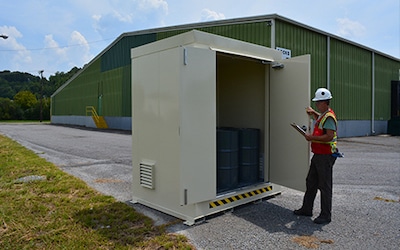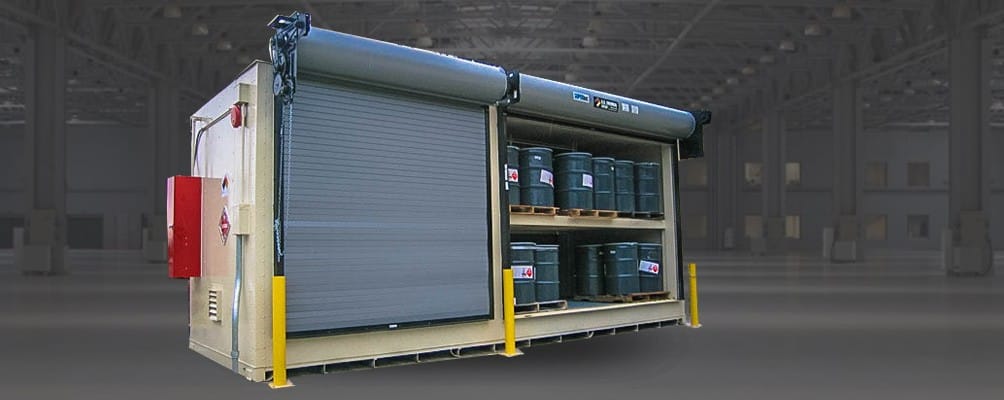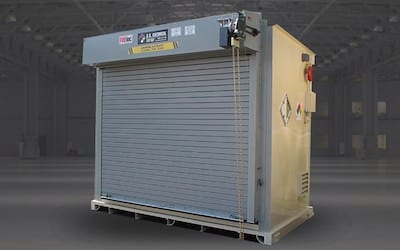Choosing a Chemical Storage Building is Easy
Knowing how to choose a proper chemical storage building for your application can be intimidating. Regulators, insurance underwriters, and safety officials have strict standards, while suppliers provide numerous options with varying degrees of expertise. Disregarding regulations can become very costly, not to mention the danger to human life, wildlife, and natural resources.The Occupational Safety and Health Administration (OSHA) holds companies accountable for creating and maintaining a safe working environment. In 2023, OSHA fined a Missouri chemical plant $393,000 for accruing 16 violations after receiving 24 violations in 2021.
Investigations revealed some of these violations stemmed from placing their employees at risk of exposure to dangerous chemicals, including ethylene oxide. They also had an inadequate medical evaluation procedure for employees exposed to this chemical.
Situations like this may prompt you to wonder: how can you keep employees safe and meet regulatory requirements at a reasonable cost? There are many types of buildings with various features. How do you know which one is right for your needs?
Follow these 5 steps to choose the right chemical storage building for you:
How to Choose a Chemical Storage Building
Step 1: Identify Your Chemicals and Their Hazards
Suppliers issue a Safety Data Sheet (SDS) with every chemical. It describes the properties of the chemical and the hazards associated with it.Review the SDS to identify hazardous, flammable, or combustible chemicals. Each category has specific requirements for proper storage. Incompatible chemicals may be stored in separated rooms within one building or in separate buildings.
Depending on their location in proximity to other occupied buildings or property lines, chemical storage buildings may require fire-rated construction. Flammables and other chemicals with low flash points will need explosion-proof electrical components.
Exhaust fans, fire suppression, and other components could be required to remain compliant with local and national regulations. Always consult with your local code authority and discuss plans with them so you can be sure how to choose a proper chemical storage building if you are ever concerned about your situation. They are ultimately the final say in your project’s approval, so developing a relationship with them early in the process is always a good idea.
Step 2: Decide on Your Storage Location
International Building Code (IBC), NFPA, OSHA, and other governing bodies set requirements for the proper storage of any chemicals, including flammables, combustibles, corrosives, oxidizers, organic peroxides, pesticides, etc.The construction requirements depend on the proximity of the chemical storage to occupied buildings and property lines. Remember, right-of-way buffer zones count as property lines. Select a fire rating for your chemical storage building based on these criteria:
- 4-hour fire rating for within 10 feet outside of or inside an occupied building
- 2-hour fire rating for between 10 and 30 feet away from other buildings outside
- Non fire-rated for more than 30 feet away from other buildings or property outside
Step 3: Determine Your Storage Volumes and Weight
To determine the proper building size and footprint, you must identify the types and numbers of containers to be stored. Understanding the inventory ensures the size of the building and the spill containment are compliant and optimal for your application.U.S. Chemical Storage buildings feature elevated flooring. This is due to the secondary containment sump underneath, which catches spills. Select the standard elevated flooring with a load rating of 500 lb. psf, or specify a higher rating according to your needs.
Standard widths and lengths of chemical storage buildings are 6-, 8-, 10- and 12-feet, but they can extend up to 52 feet. Choose a combination of standard units or customize a building to the size you need.
Step 4: Specify Your Openings, Racks, and Shelving
The design of a chemical safety building should make transferring chemicals easy. Customers can specify the number of openings. Choose entry ramps or steps as well as racks or shelving systems.Multi-tier racks are available for totes and pallets or drums. Their heavy gauge construction makes them capable of enduring long years of daily wear and tear, loading and unloading. Select horizontal drum racks for gravity dispensing.
Choose sump shelving to contain small leaks and spills on the shelf. It is easier to clean a small shelf spill than a large spill in the secondary containment sump. Durable and strong, the steel construction handles heavy load requirements.
Step 5: Make Sure You Have Spill Containment
Secondary containment is an integrated sump that catches spills and leaks inside the building. U.S. Chemical Storage buildings offer Environmental Protection Agency (EPA) and OSHA-compliant sumps.Standard spill containment sumps are made using continuously welded 10-gauge steel sheets at the base, as well as structural steel tubing, to create the vertical walls for the containment.
Each U.S. Chemical Storage sump is tested at the factory to be leakproof. Sumps prevent spills from leaving the building and polluting the environment.
Choosing a Proper Chemical Storage Building – Download the infographic
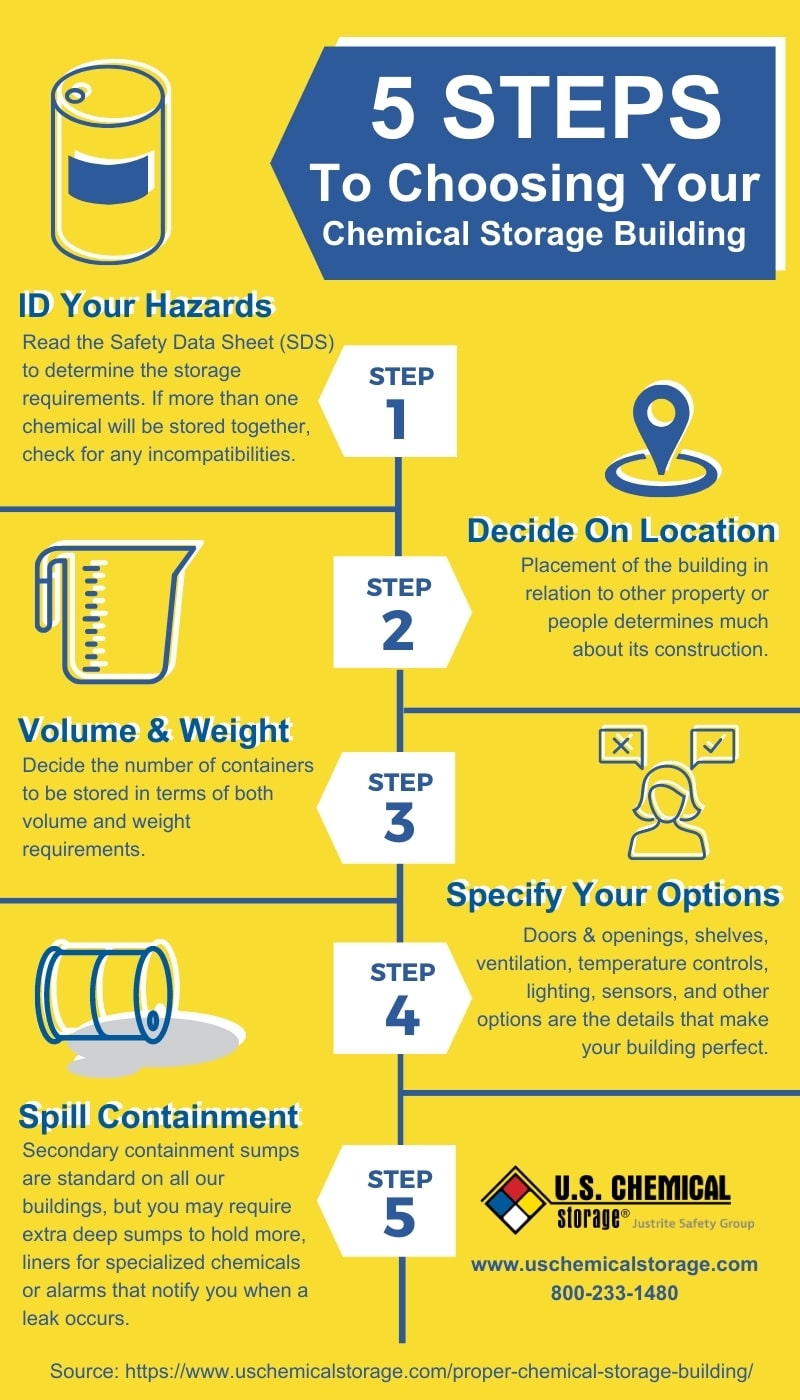


Types of Chemical Storage Buildings
Storage buildings must conform to relevant code requirements, meet business needs, and serve a practical and functional purpose for operations.U.S. Chemical Storage provides standard and customized storage building designs that match your specific requirements, including:
Fire Rated Chemical Storage Buildings
Fire-rated storage buildings are designed to meet UL fire-rated construction requirements for the compliant storage of flammables, combustibles, and other hazardous materials.Two-hour fire-rated storage buildings are available in both uni-directional and bi-directional designs. They meet requirements for storage of flammable and combustible materials located within 10 to 30 feet of an occupied building or property line.
Fire protection is provided by multiple layers of fire-resistant gypsum board encased in galvanneal steel sheets. Four-hour fire-rated storage buildings have the additional fire resistance provided by mineral wool insulation.
These buildings meet requirements to be located inside or within 10 feet of an occupied building and can have explosion-proof features.
Non-Fire-Rated Chemical Storage Buildings
Non-fire-rated storage buildings are used to store hazardous at locations 30 feet or greater from occupied buildings or property lines.Built-in containment sumps form an integral part of the solution for non-fire-rated storage buildings, ensuring any spill can be contained inside the building and will not contaminate the environment.
Sturdy construction provides security and protection from natural hazards like temperature extremes, high winds, and even seismic activity.
Corrosion Resistant Chemical Storage Buildings
Corrosion-resistant coatings can be applied to steel and are used in areas where there is a high risk of corrosion.Shelves are available in both galvanized and stainless steel. These shelves have a 2-inch lip to provide spill containment in this area of storage, in addition to the spill containment located within the building.
Fiberglass floor grating and HDPE spill containment liners are available to resist corrosive hazardous materials stored within our buildings.
Chemical Storage Building Accessories
- Fire suppression systems are used to automatically dispense a fire extinguishing material into the storage building immediately when a fire is detected.
- Dry chemical systems, CO2 systems, and water sprinklers are all available as an integrated solution with the storage unit.
- Alarms can also be activated, and manual switches enable operators to activate release in emergency situations.
- Emergency and standard lighting is available for inside and outside the building and can be specified as explosion-proof depending on the environment and applications.
- Climate control is important for some chemicals. High temperatures can be hazardous in terms of the ignition of fumes, and low temperatures can cause some chemicals to crystallize. Air conditioning or refrigeration units keep temperatures down, while heating units can keep temperatures up.
- Doors of storage buildings can be chosen according to specific needs. Roll-open doors are convenient for loading and unloading large containers such as pallets or IBC totes, while swing doors can be fitted with hold-open devices and panic bars.
- Ramps can be fitted to entrances with drum dollies and carts for easy access.
- Spill detection devices are located within a sump. Dangerous spills in explosion-proof or non-explosion-proof buildings are detected and reported for an appropriate safety response. They can set off local alarms or be connected to a site monitoring system.
- Exhaust fans extract harmful vapors from storage buildings. These fans are available in explosion-proof, non-explosion-proof, and corrosion-resistant classifications.
- Personal safety products like eyewash basins and safety showers can also be integrated with storage buildings to provide personnel with direct access to safety solutions.
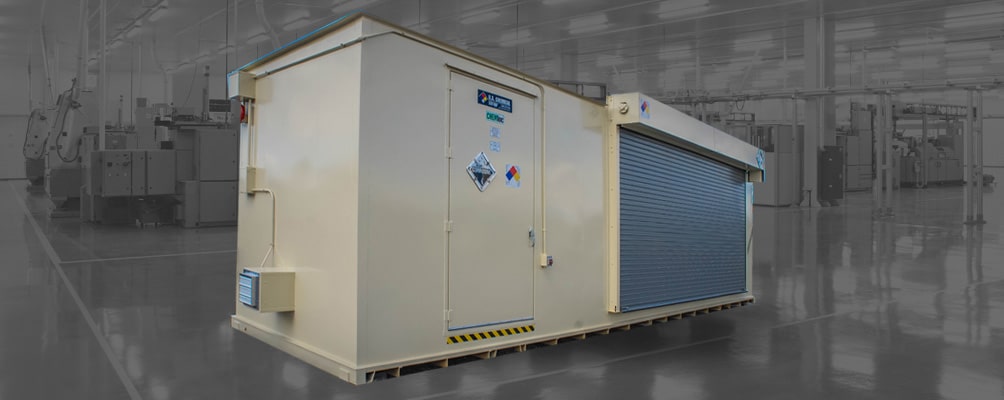


What Building Style Fits Your Needs?
How To Choose A Proper Chemical Storage Building Style: Occupancy and Non-Occupancy
Chemical storage buildings often come in two versions: occupancy and non-occupancy. So, which storage building do you select? How do you configure it to best suit your space? Being specific and realistic about the building’s use will help you choose a proper chemical storage building.Occupancy-style walk-in storage buildings allow workers to enter the building. Workers can perform tasks and chemical processes or load and unload storage containers from inside the hazmat storage building.
Non-occupancy-style rack chemical storage buildings do not allow worker access in normal use. They receive drums or totes onto racks using forklifts or other mechanical loading devices.
Occupancy (Walk-In Style) Chemical Storage Buildings
Single drum or small container storage uses walk-in-style chemical storage buildings. Double entry doors allow pallet loading or personnel access with a drum dolly.Optional ramps simplify the loading and unloading of drums. Standard or customized shelving solutions enable the storage of small bottles and chemical containers. A specialized use of walk-in style storage buildings is for process isolation.
Use mixing or dispensing rooms to segregate these hazardous activities from other operations. Containment sumps capture spills while shelving and worktops match workflow requirements.
Fit fume hoods and emergency safety showers into process isolation hazardous material storage buildings for employee safety. Other specialized applications of walk-in style buildings include:
- Mixing Rooms
- Dispensing Rooms
- Laboratories
- Mixed Use Buildings
- Household hazardous waste buildings to segregate incompatible materials
- Storage or charging of lithium batteries
- Turf chemical storage where smaller container sizes are mixed in with large containers
Non-occupancy (Rack Style) Chemical Storage Buildings
A common use of rack-style storage is for storing pallets containing chemical drums. Pallets load into bays that are one or two pallets deep, and buildings have one or two tiers.Up to 48 palletized loads (192 drums) can fit into a single rack-style storage building – but even more when using a modular configuration. Racks are adjustable to suit pallet loads or totes, depending on the need.
Doors on rack-style hazmat storage buildings cater to forklift access. Options include roll-up, hinged, or sliding doors. It is even possible to fit front and rear doors for easy access to any pallet in storage.
Safety Features for Chemical Storage Buildings
Both walk-in style and rack-style chemical storage buildings can be customized with any available safety feature. Buildings can be non-fire-rated or have a 2-hour or 4-hour fire rating.All buildings feature containment sumps to capture spills and leaks. Climate control, explosion relief panels, forced ventilation, or fire suppression systems can all be added to your storage building.
Always check with your local authorities on what building features you need for your application.
Contact Us
Contact U.S. Chemical Storage to learn how to choose a proper chemical storage building that fits your needs. Our professional consultants help you find the best solution for your application and discuss your building options with you.We provide free quotes of solutions that meet regulatory requirements and protect your assets, employees, and local environment.
References:
- U.S. Department of Labor, US DEPARTMENT OF LABOR PROPOSES $393K IN FINES AFTER FOLLOW-UP INSPECTION FINDS VERONA, MISSOURI CHEMICAL PLANT CONTINUES TO ENDANGER WORKERS
- National Fire Protection Association, Flammable and Combustible Liquids Code
- U.S. Chemical Storage Fire Suppression
- U.S. Chemical Storage Accessories
- U.S. Chemicals Storage Products

